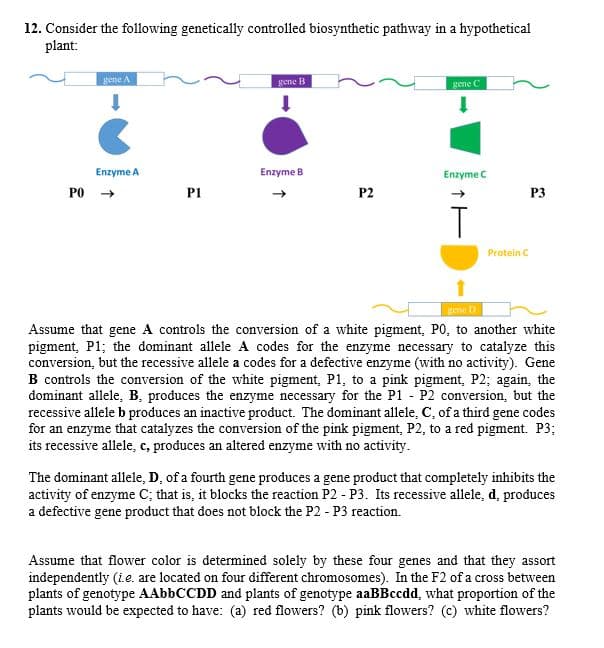12. Consider the following genetically controlled biosynthetic pathway in a hypothetical plant: gene A gene B gene C Enzyme A Enzyme B Enzyme C PO - P1 P2 P3 Protein C Assume that gene A controls the conversion of a white pigment, P0, to another white pigment, P1; the dominant allele A codes for the enzyme necessary to catalyze this conversion, but the recessive allele a codes for a defective enzyme (with no activity). Gene B controls the conversion of the white pigment, P1, to a pink pigment, P2; again, the dominant allele, B, produces the enzyme necessary for the P1 - P2 conversion, but the recessive allele b produces an inactive product. The dominant allele, C, of a third gene codes for an enzyme that catalyzes the conversion of the pink pigment, P2, to a red pigment. P3; its recessive allele, c, produces an altered enzyme with no activity. The dominant allele, D, of a fourth gene produces a gene product that completely inhibits the activity of enzyme C; that is, it blocks the reaction P2 - P3. Its recessive allele, d, produces a defective gene product that does not block the P2 - P3 reaction. Assume that flower color is determined solely by these four genes and that they assort independently (i.e. are located on four different chromosomes). In the F2 of a cross between plants of genotype AAbbCCDD and plants of genotype aaBBccdd, what proportion of the plants would be expected to have: (a) red flowers? (b) pink flowers? (c) white flowers?
12. Consider the following genetically controlled biosynthetic pathway in a hypothetical plant: gene A gene B gene C Enzyme A Enzyme B Enzyme C PO - P1 P2 P3 Protein C Assume that gene A controls the conversion of a white pigment, P0, to another white pigment, P1; the dominant allele A codes for the enzyme necessary to catalyze this conversion, but the recessive allele a codes for a defective enzyme (with no activity). Gene B controls the conversion of the white pigment, P1, to a pink pigment, P2; again, the dominant allele, B, produces the enzyme necessary for the P1 - P2 conversion, but the recessive allele b produces an inactive product. The dominant allele, C, of a third gene codes for an enzyme that catalyzes the conversion of the pink pigment, P2, to a red pigment. P3; its recessive allele, c, produces an altered enzyme with no activity. The dominant allele, D, of a fourth gene produces a gene product that completely inhibits the activity of enzyme C; that is, it blocks the reaction P2 - P3. Its recessive allele, d, produces a defective gene product that does not block the P2 - P3 reaction. Assume that flower color is determined solely by these four genes and that they assort independently (i.e. are located on four different chromosomes). In the F2 of a cross between plants of genotype AAbbCCDD and plants of genotype aaBBccdd, what proportion of the plants would be expected to have: (a) red flowers? (b) pink flowers? (c) white flowers?
Biology: The Dynamic Science (MindTap Course List)
4th Edition
ISBN:9781305389892
Author:Peter J. Russell, Paul E. Hertz, Beverly McMillan
Publisher:Peter J. Russell, Paul E. Hertz, Beverly McMillan
Chapter6: Energy, Enzymes, And Biological Reactions
Section: Chapter Questions
Problem 6TYK: Which of the following methods is not used by enzymes to increase the rate of reactions? a. covalent...
Related questions
Question

Transcribed Image Text:12. Consider the following genetically controlled biosynthetic pathway in a hypothetical
plant:
gene A
gene B
gene C
Enzyme A
Enzyme B
Enzyme C
PO →
P1
P2
P3
Protein C
eme D
Assume that gene A controls the conversion of a white pigment, PO, to another white
pigment, P1; the dominant allele A codes for the enzyme necessary to catalyze this
conversion, but the recessive allele a codes for a defective enzyme (with no activity). Gene
B controls the conversion of the white pigment, P1, to a pink pigment, P2; again, the
dominant allele, B, produces the enzyme necessary for the P1 - P2 conversion, but the
recessive allele b produces an inactive product. The dominant allele, C, of a third gene codes
for an enzyme that catalyzes the conversion of the pink pigment, P2, to a red pigment. P3;
its recessive allele, c, produces an altered enzyme with no activity.
The dominant allele, D, of a fourth gene produces a gene product that completely inhibits the
activity of enzyme C; that is, it blocks the reaction P2 - P3. Its recessive allele, d, produces
a defective gene product that does not block the P2 - P3 reaction.
Assume that flower color is determined solely by these four genes and that they assort
independently (ie. are located on four different chromosomes). In the F2 of a cross between
plants of genotype AAbbCCDD and plants of genotype aaBBccdd, what proportion of the
plants would be expected to have: (a) red flowers? (b) pink flowers? (c) white flowers?
Expert Solution
This question has been solved!
Explore an expertly crafted, step-by-step solution for a thorough understanding of key concepts.
This is a popular solution!
Trending now
This is a popular solution!
Step by step
Solved in 3 steps with 1 images

Knowledge Booster
Learn more about
Need a deep-dive on the concept behind this application? Look no further. Learn more about this topic, biology and related others by exploring similar questions and additional content below.Recommended textbooks for you

Biology: The Dynamic Science (MindTap Course List)
Biology
ISBN:
9781305389892
Author:
Peter J. Russell, Paul E. Hertz, Beverly McMillan
Publisher:
Cengage Learning

Biology (MindTap Course List)
Biology
ISBN:
9781337392938
Author:
Eldra Solomon, Charles Martin, Diana W. Martin, Linda R. Berg
Publisher:
Cengage Learning

Biology: The Dynamic Science (MindTap Course List)
Biology
ISBN:
9781305389892
Author:
Peter J. Russell, Paul E. Hertz, Beverly McMillan
Publisher:
Cengage Learning

Biology (MindTap Course List)
Biology
ISBN:
9781337392938
Author:
Eldra Solomon, Charles Martin, Diana W. Martin, Linda R. Berg
Publisher:
Cengage Learning